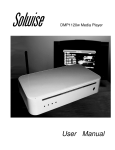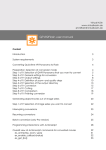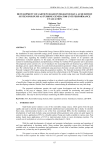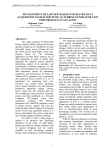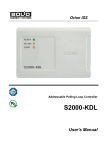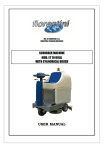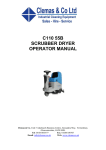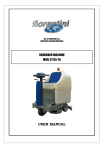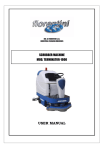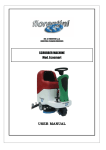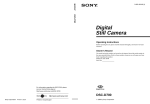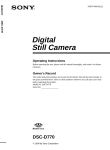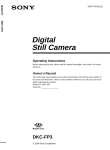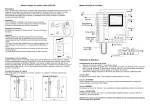Download R. Slota - Integrated System for Hydrometric Data Processing and
Transcript
IGHEM 2000 Hydrometrics Ltd. Page 1 /14 HYDRO 11 Integrated System for Hydrometric Data Processing and Discharge Calculation in Open Channels and Closed Conduits Author : Rastislav Slota, Hydrometrics Ltd., Slovak Republic E-mail : [email protected] , [email protected] Demo version available on : www.hydrometrics.cz Introduction HYDRO11 software product is an original, powerful and easy-to-use integrated system for hydrometric data processing and discharge calculation, that has been originally developed for internal needs of Hydrometrics Ltd. company. HYDRO11 package might be useful in the field of hydrology, hydraulic engineering and hydraulic research, simply in most cases where it is necessary to measure and evaluate discharge of water (or other liquids) using velocity–area methods according to international standards ISO 748 and ISO 3354. The range of possible practical application covers flow measurements in natural watercourses, artificial channels, sewers and measuring flumes, as well as pressure pipelines, penstocks and turbine inflows. The program‘s main features are related especially to user-friendly interface, well arranged processing of the input data (including automatic registration of measured data), visualization and interactive approach during the discharge calculation, graphical and text data export for post-processing and presentation, etc. The structure of HYDRO11 application consists of two independent executable modules: HYDRO11 EDITOR and HYDRO11 Computational module. The EDITOR module includes a set of various pre-prepared dialoque boxes, forms and tables for cross-sectional geometry input, propeller calibration-constants database, propeller identification matrix, as well as the measurement data input for each measuring method and cross-section type supported. In addition to the manual data input, it is possible to use also an internal Impulse Counter utility that allows (in connection with a special hardware equipment) automatic registration of current meter impulses and transmits the data directly into the appropriate data sheet. If any other measuring instrument is used instead of the propeller current meter (for example electro-magnetic current meter), the point velocity matrix can be entered directly. All data required for discharge calculation is stored within a well-arranged structure of internal data files. The discharge calculation itself is carried out by means of the HYDRO 11 Computational Module. Flow Cross-Section Types The program supports six basic cross-section types including some additional modifications : Open Rectangular, Open Circular, Open General (non-symmetrical), Open Symmetrical (usually egg-shaped), Closed Rectangular (including a sub-type with 45° slant corners) and Closed Circular. This range covers almost 99 % of all measuring sites from the hydrometrical practice. In the terminology used within HYDRO11, "open" type means a cross-section with free water surface flow regime and "closed" type means a cross-section with full pressureflow regime. A "measuring project", that user creates in order to prepare all input data necessary for discharge calculationin in a certain location, is allways related to one selected cross-section type, for which several measurement records can be created afterwards. Generally, for "open" types a fixed number of measuring verticals must be defined and a number of measuring points per each vertical may vary from record - to record, from vertical – to vertical. For "closed" type a fixed number of measuring points must be defined and it remains constant for all measurement records related. Picture01.GIF picture 1 : HYDRO11 - Flow Cross-Section Types Supported IGHEM 2000 Hydrometrics Ltd. Page 2 /14 Measuring Methods The choice of the method of flow velocity measurement depends on certain factors. These are : time available, width and depth of the cross-section, rate of variation of level, degree of accuracy required and measuring equipment used. According to ISO 748, these methods are classified as follows : - Velocity distribution method Reduced point method Integration method Other methods HYDRO11 program recognizes two basic methods of flow velocity measurement. For the purposes of discharge evaluation in HYDRO11 we will consider the “Point velocity method” (as a common method including Velocity distribution method and Reduced point method) and the Integration method. Other methods (like Surface onepoint method, etc.) are not supported here. Using a “Point velocity method”, values of flow velocity are obtained from observations at number of measuring points properly distributed throughout the whole cross-section area. The number and spacing of points should be chosen as to define accuratelly the velocity distribution on each vertical, resp. arm (circular cross-section type). In HYDRO11, this measuring method is available for all cross-section types listed above and also for both measuring instrument options (propeller current meter as well as electro-magnetic probe). If using an "Integration method", the current meter is lowered and rised trough the entire depth on each vertical at a uniform rate. Using propeller current meters, the mean vertical velocity can be calculated from instrument calibration as equivalent to the average number of revolution divided dy the total integration time. In HYDRO11, this measuring method is available for Open Rectangular, Open General and Closed Rectangular cross-section types. Computing Method HYDRO11 software uses full graphical method of discharge computing in accordance with ISO 748 (Measurement of liquid flow in open channels, velocity – area methods) and ISO 3354 (Measurement of clean water flow in closed conduits, velocity – area methods). This method, comparing to numerical methods and combination of numerical and graphical methods, is recognized as the most accurate one. The principle of the graphical method, in general, is to exactly calculate the area bounded by velocity distribution curve, crosssection boundaries and / or water level. The integral form that is applied in individual case depends on the crosssection type and measuring method used. In general, the computing method can be described by following expressions : - Mean Vertical Velocity Calculation (applied in all open section types and closed rectangular cross-section type, using point velocity measuring method) v= v H vb 1 H . vb .dh H ∫0 … is the mean vertical velocity … is the mean vertical depth ... is the point velocity in distance h from bottom, that comes from velocity distribution curve vb = f ( h ) - Discharge Calculation (applied in all cases mentioned above and also in integration measuring method) B Q = ∫ v.H .db 0 IGHEM 2000 Q B v - Hydrometrics Ltd. Page 3 /14 … is discharge … is breadth of flow cross-section … is the mean vertical velocity in distance b from left bank, that comes from velocity distribution curve v = f ( b ) Discharge Calculation (applied in closed circular cross-section) 2π R Q= R r φ vb ∫0 ∫0 vb .dr.dϕ … is cross-section radius … is distance from the middle of cross-section … is arm orientation angle from the vertical position … is velocity in the point of polar coordinates [ϕ, r], that comes from velocity distribution curve vb = f ( ϕ , r ) Velocity Distribution Curve is any suitable polynomical function that fluently connects measured point velocities, resp. mean vertical velocities. In HYDRO11 computational module a set of cubic spline functions is used for velocity distribution approximation. Spline functions are partial polynomical functions that are connected in measuring points and have the same second derivation in this point. The algorithm using a set of cubic spline functions is very stable for unlimited number of measuring points and for any distance distribution of measuring points throughout the cross-section (unlike other polynoms of higher power, e.g. Newton‘s interpolation polynom for non-equidistant spacing etc.). Partial cubic spline function that is applied for interval from Xi to Xi+1 can be described by following general equation using variables x and y y = ai .x2 + bi .x + ci ai, bi, ci … are function parameters applied for partial interval Xi to Xi+1 This non-linear polynomical interpolation is valid in range from the first to the last measured point but it is also necessary to describe velocity distribution curve near cross- section boundaries, i.e. between the first (or last) measured point and flow cross-section bank, bottom or pipe wall. In this case the power approximation is used for velocity calculation in accordance with recommendations of ISO 748 and ISO 3354. Velocity distribution curve is defined by following equation ⎛ x⎞ y = Y1 .a.⎜⎜ ⎟⎟ ⎝ X1 ⎠ 1 /m m … is boundary layer coefficient that usually varies between 2 and 14 Coefficient m depends on flow cross-section boundary hydraulic roughness. For purposes of discharge calculation in HYDRO11 the value of this coefficient has been estimated according to shape of the first spline polynom so that the two curves have the same derivation in connecting point. Picture02.GIF picture 2 : HYDRO11 - Approximation of Measured Point Flow Velocities by Spline Function There are various methods for area A integration, including classical planimetry, simple arithmetical formulas, numerical integration and also analytical solution of definite integral but only the two last ones could be taken into account for precise calculation of discharge on computers. In addition to approximation type (oblong, Simpson, Gauss, etc.), the accuracy of numerical integration depends mainly on the differential step count, so increasing of step count causes increasing of accuracy but computing itself may take extremly long time. On the IGHEM 2000 Hydrometrics Ltd. Page 4 /14 other hand, the analytical solution of integral is exact and very fast. That is the reason why HYDRO11 computational module uses only this method in each calculation procedure. Following equation shows the application of analytical solution in general form. The equation might be adapted in each particular case depending on cross-section type. n− 1 X i+ 1 X1 A = ∫ (a.x )dx+ ∑ m i= 1 0 ∫ (ai.x X 3 + bi.x2 + ci.x + di )dx = i X1 X i+ 1 n− 1 ⎡ xm + 1 ⎤ ⎡ x4 ⎤ x3 x2 = ⎢ a. + a . + b . + c . + di.x⎥ ∑ i i ⎥ ⎢ i 4 3 2 i= 1 ⎣ ⎣ m + 1⎦ 0 ⎦ Xi This algorithm – comparing to a numerical integration method - works very quickly on relative less powerful PC-s as well and user will probably appreciate it if performing an interactive graphical editation of point velocities when discharge changes are recalculated simultaneously with moving the measured point velocities and /or surface velocity. Picture03.GIF picture 3 : HYDRO11 - Integration of Velocity Distribution Curve throughout Vertical Depth Picture04.GIF picture 4 : HYDRO11 - Integration of v-H Curve throuhgout Cross-Sectional Breadth Picture05.GIF picture 5 : HYDRO11 - Integration of Discharge in Closed Circular Cross-Section Structure of Program Files The essential part of the HYDRO11 system consists of two executable files EDITOR.EXE and HYDRO11.EXE. Program's start up settings are stored in HYDRO11.INI initialization file, licence information is stored in HYDRO11.USR user identification file. For storing all data necessary for discharge calculation, a structure of data files is created for each particular "measuring project". This structure consists of ". MAK" (project information file), ". PRF" (cross-section definition file), ". CAL" (calibration constants database), ". MER" (measurement records data file) and ". BAK" (measurement records backup data file). The HYDRO11 EDITOR application uses also two types of data-import files – " .VPN" (cross-section templates) and " .0XX" (userdefined measurement data import). In addition to these files, there are two output text files available for exporting the measured data - IMPULSES.TXT (direct output from the Impulse Counter utility – pure matrix of measured impulses) and TABLE.TXT (discharge measurement protocol) from the HYDRO11 Computational Module. Picture06.GIF picture 6 : HYDRO11 - Structure of Program Files and I /O Interfaces Executable Files EDITOR.EXE HYDRO11 EDITOR application is a well arranged set of sheets, panels and dialoque boxes that allow user to prepare hydrometric measurement data for discharge computing. These data are then processed by means of HYDRO11 Computational Module. EDITOR is full independent part of the software package and could be run IGHEM 2000 Hydrometrics Ltd. Page 5 /14 without HYDRO11 Computational Module (and even without MS WINDOWS environment in DOS full-text regime). However, anytime it could be called from HYDRO11 environment. Picture07.GIF picture 7 : EDITOR.EXE - Program Menu Overview There are several ways how to enter / import data into the EDITOR. As default, user can enter all the data manually – using PC keyboard, but there are some cases where you can use also data import from text files (e.g. cross-section templates) or automatic data (impulses) import from the Impulse Counter utility, that has been integrated into the HYDRO11 EDITOR environment. HYDRO11.EXE is full WINDOWS application for hydrometric data processing, discharge computing and measured data export and presentation. The application has been primarily designed for WINDOWS 95 and 98 environment. The program consists of a main form (including working area, pop-up menus, list- and dialogue boxes) for graphics displaying as well as several additional forms for table data output. HYDRO11 allows computing discharge, drawing flow-velocity distribution curves and isolines, printing or exporting graphics and tabular outputs. Picture08.GIF picture 8 : HYDRO11.EXE - Program Menu Overview Start–Up Files HYDRO11.USR User identification file HYDRO11.USR contains coded information on serial number, user’s company name and address. It must be installed in the same directory with executable files. Executable files allways look for this file during start and check the code information. If the information is incorrect or USR file does not exist, HYDRO11 software will automatically run in demonstration version. Demonstration version is identical with full working version but does not allow you to create or edit data files. That means you can work with all existing data files but cannot create new “measuring projects”, save changes in cross-section parameters, edit calibration constants database and add, edit or erase measurement records. Demonstration version distributed with a set of sample data files allows potencial user to try all functions and features offered by HYDRO11 software but disables its commercial usage. To upgrade a demonstration version to full working version, simply copy the HYDRO11.USR identification file into the working directory. HYDRO11.INI HYDRO11.INI---------------------------------Hydro11_Language = ENGLISH Hydro11_Output_Editor = C:\DOS\QBASIC /EDITOR Hydro11_K_Factor = 1 Editor_Language = ENGLISH Editor_Back_Color = TRUE Editor_Mouse_Cursor = TRUE Editor_Impulse_Filter = TRUE Editor_Filtration_Coefficient = 0.5 Editor_Transmit_Count = 96 Editor_Auto_Timer = 0 Editor_AX5214_Setting = 1000100 Editor_AX5214_Setting = 1000011 Editor_Counter_Matrix : 001,002,003,004,005,006,007,008,009,010,011 012,013,014,015,016,017,018,019,020,021,022 023,024,025,026,027,028,029,030,031,032,033 034,035,036,037,038,039,040,041,042,043,044 045,046,047,048,049,050,051,052,053,054,055 056,057,058,059,060,061,062,063,064,065,066 067,068,069,070,071,072,073,074,075,076,077 078,079,080,081,082,083,084,085,086,087,088 089,090,091,092,093,094,095,096,097,098,099 100,101,102,103,104,105,106,107,108,109,110 ------------------------------------------- IGHEM 2000 Hydrometrics Ltd. Page 6 /14 Initialization file HYDRO11.INI is a text ASCII file containing various settings and parameters that are automatically logged with every new start of executable files HYDRO11.EXE and EDITOR.EXE. Some of them are read also in particular cases during run of the system. This file is not unconditionally necessary for running the system, i.e. executable files will run without initialization file as well (with default settings) but creating INI-file user can keep his own settings to be initialized with every next start. Initialization file may be created and updated by means of arbitrary text editor or directly from HYDRO11 working desktop. Parameters and settings included in the initialization file – in general - are related to program desktop environment as well as to some special functions like Impulse Counter, Data Export, etc. Structure of Data Files Picture09.GIF picture 9 : HYDRO11 - Structure of Data Files FILENAME.MAK Project Macro File containes all data file names related to the individual measuring project. Opening this file from HYDRO11 environment all shared data files are automatically loaded as well. SAMPLE_1.MAK---------------------------------sample_1.prf constant.cal sample_1.mer ---------------------------------------------- FILENAME.PRF Cross-Section Definition File (sequential data file) containes location and measuring object description, crosssection parameters (cross-section type, measuring instrument, measuring method, etc.), cross-section definition (geometrical shape and dimensions, measuring verticals resp. points distribution, etc.), current meters identification matrix and other parameters. FILENAME.CAL Current Meters Calibration Constants Database (sequential data file) containes calibration constants of all propeller current meters available. It is not necessary to create this file again and again for each particular measuring project. User must prepare the database just once and this file can be included to each newly created project. User just marks which current meter to use in which position (measuring point). This selection is defined by current meters identification matrix in PRF file. FILENAME.MER Measurement Data File (random-access data file) containes all measurements carried out in the cross-section defined in PRF file. This file includes measurement date and hour, meas. time, water depth and meas. points distribution in each vertical (only for open cross-section types), propeller revolution count (resp. flow velocity) for each meas. point, etc. All measurement saved in MER file have a fixed record length according to crosssection definition. In closed cross-section types, this record length comes from the constant number of measuring points, in open cross-section types (where the number of measuring points on a vertical may vary) the record length comes from the fixed number of measuring verticals and a maximum defined number of measuring points per vertical (a mandatory parameter). Any of existing records can be chosen from the record-list in order to be updated, saved as new record or erased. FILENAME.BAK Measurement Backup File that is the last backup copy of measurement (MER) file. This file is updated (or automatically created if does not exist) anytime you make changes in MER file. It could be helpful, for example, in case you have deleted some record and want to restore it back. Simply rename this BAK file to original MER IGHEM 2000 Hydrometrics Ltd. Page 7 /14 file name and load the project again. A backup data file name may not be included in macro file list. Its’ file name automatically comes from measurement file name, just the extension is changed. Data-Import Files FILENAME.VPN For some cross-section types, that are usually defined by a great number of definition points (open general and open symmetrical), it is possible to prepare several cross-section templates (VPN files) that can be imported directly into the cross-section definition table (EDITOR). This feature saves user's time while defining the crosssection geometry manually and is suitable especially for frequently used locations. User can create and / or modify these templates himself. FILENAME.0XX This type of data-import file can be optionally used for measurement data imput as an alternative to manual data input and / or the integrated Impulse Counter utility. For example, if any other software is used for current meter impulses registration, this file represents a custom interface between the software and HYDRO11 EDITOR application. This file format is usually modified for each particular user according to specific requirements – upon request. Data-Output Files IMPULSES.TXT This output text file is automatically created (or updated) if you want to save a pure propeller impulses matrix from the Impulse Counter utility – without transfering the impulses into the measurement data sheet. To do this, you do not have to open a measuring project – the measured impulses are allways saved as 11 x 10 matrix. This feature might be helpful if you want to create several quick measurements without delay and it is an alternative to a regullar measurement data record. TABLE.TXT This output text file containes a complete measuring protocol including point velocities, mean vertical / section velocities, mean water level, discharge calculated, cross-sectional area, hydraulic radius, etc. If an external output editor has been defined in initialization file, this external text editor can be called directly from HYDRO11 environment and the document can be automatically opened, formated and / or printed within this editor. Creating New Measuring Project Following comes the general description of creating new "measuring projects" within the HYDRO11 EDITOR application. Several data sheets ane dialogue boxes may differ from project to project depending on cross-section type and measuring method selected, but the procedure of building the data-files structure for each particular project remains unchanged. In the terminology used within HYDRO11, the term "measuring project" means a set of data files and measurement records related to the particular location / object (that is defined as one of cross-section types supported). Following are the mandatory steps necessary for thr project definition : - definition of project's data file-names cross-section parameters setting cross-section geometry and dimensions definition preparing calibration constants database (if not existing) propeller current meters assignment setting the ratio between impulses and propeller revolutions creating measurement data records IGHEM 2000 Hydrometrics Ltd. Page 8 /14 Definition of Project's Data File-Names Picture10.GIF picture 10 : HYDRO11 EDITOR - Definition of a New Project The project's data file-names are usually identical to the project macro file (MAK), except for the calibration constants database, that is usually common for several projects. All types of data files (i.e. PRF, CAL, MER) are stored in the project macro file (MAK) and the access is automatically established by loading the macro file into the HYDRO11 environment. Once the measuring project has been defined (or opened), all data sheets and values are automatically accessed to the appropriate data files when saving changes during the project definition process. This accessibility is fully controlled by the EDITOR itself. Cross-Section Parameters Setting Picture11.GIF picture 11 : HYDRO11 EDITOR - Cross-Section Parameter Settings Before starting geometry definition, it is necessary to select a cross-section type, measuring method, measuring equipment as well as some additional parameters that explicitly define the cross-section itself and also the appearance of all forms and tables for data input. The appearance of "Parameter Settings" dialogue box dynamically changes according to the cross-section type selected, because some parameters may not be accessible for other cross-section types, etc. Due to this feature, user simply cannot set any unlogical parametercombination that makes no sense in the selected context. Cross-Section Geometry and Dimensions Definition This is the essential phase of the cross-section definition process that may influence the total uncertainty of the discharge calculation. To define the cross-section properly, it is necessary to take into account the basic rules (conventions) for the geometry input. Generally, the cross-section shape can be defined either by entering inside dimensions in case of regular cross-section types (breadth, height – rectangular type, diameter – circular type) or by a set of coordinates in case of irregular types (open general, open symmetrical). If using the coordinates, measuring verticals must be defined in the same coordinate system as the cross-section itself. It is also very important to preciously define, how and where the water level is measured (open cross-section types), etc. In addition to these basic conventions, there are some specific limits and restrictions for each particular type described in the comprehensive User's Manual. Following are some figures and HYDRO11 EDITOR screenshots for each cross-section type that describe it's geometry definition : Picture12a.GIF picture 12a : Open Rectangular Cross-Section Definition Schema Picture12b.GIF picture 12b : HYDRO11 EDITOR - Open Rectangular Cross-Section Definition Sheet Picture13a.GIF picture 13a : Open Circular Cross-Section Definition Schema Picture13b.GIF picture 13b : HYDRO11 EDITOR - Open Circular Cross-Section Definition Sheet IGHEM 2000 Hydrometrics Ltd. Page 9 /14 Picture14a.GIF picture 14a : Open Symmetrical Cross-Section Definition Schema Picture14b.GIF picture 14b : HYDRO11 EDITOR - Open Symmetrical Cross-Section Definition Sheet Picture15a.GIF picture 15a : Open Non-Symmetrical (General) Cross-Section Definition Schema Picture15b.GIF picture 15b : HYDRO11 EDITOR - Open Non-Symmetrical (General) Cross-Section Definition Sheet Picture16a.GIF picture 16a : Closed Rectangular Cross-Section Definition Schema Picture16b.GIF picture 16b : HYDRO11 EDITOR - Closed Rectangular Cross-Section Definition Sheet Picture17a.GIF picture 17a : Closed Circular Cross-Section Definition Schema Picture17b.GIF picture 17b : HYDRO11 EDITOR - Closed Circular Cross-Section Definition Sheet Preparing Calibration Constants Database In order to calculate flow velocity in each measuring point, you have to define calibration constants for each propeller current meter used in the measuring cross-section. HYDRO11 software allows you to create and use one common database of calibration constants (CAL data file including all current meters available) for all your “measuring projects”, so that you do not have to input these constants again and again when creating new projects. However, you can optionally create a new CAL file whenever you start a new project. Picture18.GIF picture 18 : HYDRO11 EDITOR - Calibration Constants Database Sheet The database of calibration constants might be periodically updated whenever you provide new calibration of propeller current meters. That is the reason why it is recommended to archive the current version of the CAL file together with each “measuring project” related. If you open any older project with recently updated calibration database, the newly calculated velocities will – of course - differ from original values. Propeller Current Meters Assignment In following step it is necessary to select which current meters (from the calibration constant database) will be used in the cross-section defined. For each measuring point of the cross-section you have to assign a unique propeller identification number into the propeller identification matrix. The format of identification numbers must correspond with identificators that have been used in the database of calibration constants (matching upper/lowercases). Picture19.GIF picture 19 : HYDRO11 EDITOR - Propeller Identification Sheet IGHEM 2000 Hydrometrics Ltd. Page 10 /14 Setting the Ratio between Impulses and Propeller Revolutions There are some older types of propeller current meters, still being used in hydrometry, that can be set to a different ratio of revolutions and electrical impulses (1:1, 2:1, 4:1, etc). The impulse transfer rate matrix allows user to define (if necessary) for each particular current meter the total number of revolutions that will generate one single electrical impulse. The default setting is “one impulse per one revolution”. A valid range includes all integer numbers higher then 0. For evaluation of flow velocities a specific revolution count (number of revolutions per second) is calculated. The total count of propeller revolutions for each particular measuring point is equal to the number of impulses multiplied by impulse transfer ratio. Specific revolution count is equal to the total count divided by integration time period. Creating Measurement Data Records Once the cross-section has been completly defined, user can create a set of measurement records that are related to the currently opened measuring project. The measurement data sheet appearance depends (in general) on the cross-section type selected (open, closed), measuring method (point, integration) and measuring equipment selected (propeller current meter, electro-magnetic current meter). Measuring records (in contrast to crosssection parameters) are stored in a random access data file (MER) that allows saving new records, as well as opening , modifying and deleting existing records. There are three basic types of measurement data sheets : - open cross-section type / point velocity method closed cross-section type / point velocity method integration method However, each of these basic data sheet types may have several additional variations according to cross-section parameters and options selected – for example entering propeller revolutions or entering directly the point velocities, entering measuring points by verticals or by horizontals, entering directly water depth or water level in the selected coordinate system, etc. Generally, for open cross-section type you must define water level, distribution of measuring points and propeller revolutions (point velocities) for each particular vertical. For closed cross-section type, just a revolutions (point velocities) matrix is entered, because the measuring points are fixed within the cross-sectional area. In case of the integration method, only the mean vertical velocity is measured in each vertical, but there is an option to take into account the bottom-point velocities, as well... In the comprehensive User's Manual, there is a full description of all measurement data-sheet templates available in the HYDRO11 EDITOR application. Following are some screenshots of the three basic measurement data sheets described above : Picture20a.GIF picture 20a : Definition of Measuring Points on Vertical Picture20b.GIF picture 20b : HYDRO11 EDITOR - Measurement Data Sheet (Open Cross-Section / Point Velocity Method) Picture21.GIF picture 21 : HYDRO11 EDITOR - Measurement Data Sheet (Closed Cross-Section / Point Velocity Method) Picture22.GIF picture 22 : HYDRO11 EDITOR - Measurement Data Sheet (Integration Method) For each particular measurement record, a current date, time, measurement number and measurement time must be entered before saving the record. Records are sorted in ascending order by the creation time. The number of measurement records per measuring project is not limited. IGHEM 2000 Hydrometrics Ltd. Page 11 /14 Impulse Counter Utility Impulse Counter Panel is relative indepenent part of the EDITOR application that is integrated into the program environment. In connection with a special hardware equipment, it allows automatic registration of propeller current meter revolutions (resp. electrical impulses) and also automatic transmission of measured impulses directly into the measurement data sheet. The hardware equipment for automatic data registration consists of standard internal DI/O modules AXIOM AX5214 with external opto-isolated D/I module AX754 and a special hardware extension for elimination of water self-conductivity, developed by Hydrometrics Ltd. Picture23.JPG picture 23 : Hardware Equipment for Automatic Data Registration The Panel containes 11 columns and 10 rows of single impulse counters that are numbered from 1 to 110. For each single counter, a space of five numerical characters is reserved on the screen (valid range of impulse count is 0 to 99999). In this version of the software, user can use up to 96 current meters simultaneously connected to the hardware interface. Impulse Counter allows processing and displaying measured data from all 96 binary input channels in real time. Picture24.GIF picture 24 : HYDRO11 EDITOR - Impulse Counter Panel Impulse counter timer, that is related to internal PC system timer, allows automatic stopping of impulse integration after a pre-defined time period (measuring time). In addition to this, the Impulse Counter allows also automatic starting and stopping the timer by means of external relay (or two relays). This feature is available only for the integration measuring method, where the timer could be synchronized with a moving construction, or a capstan motor. After the timer has stopped, the matrix of measured impulses can be transfered directly into the opened measurement data sheet. In this case, the current system date, system time and measuring (integration) time is automatically generated into the measurement record header, so it is not necessary to enter it manually. There are several ways (regimes) how to transfer the measured impulses into the EDITOR's measurement data sheet : - if using a single current meter, the Impulse Counter is started for each particular measuring point and each time the Counter stops, just a single value is transfered into the appropriate position in data sheet. - if using a set of current meters on a portable hydrometrical rod, the Impulse Counter is started for each particular measuring vertical and each time the Counter stops, a set of values is transfered at once into the appropriate vertical position in data sheet - if using a complete set of current meters that are fixed within the cross-section, all measuring points are measured simultaneously and the entire matrix of measured impulses is transfered at once into the data sheet - if using two (or more) complete sets of current meters that are fixed parallely in two (or more) identical cross-sections, all measuring points are measured simultaneously (it is not necessary to start the Counter several times) and the measured values are logically redistributed from the single Impulse Counter panel into all cross-sections at once Accessing Binary Inputs On the Impulse Counter Panel, each binary input channel might be displayed at its own Counter position. If keeping the default setting, a number of each physical input channel corresponds with the counter position on the screen. However, the EDITOR application allows you to re-arrange this setting, i.e. to change the logical order of binary inputs regardless of hardware-interface connection order of propeller current meters. The current IGHEM 2000 Hydrometrics Ltd. Page 12 /14 setting is saved in HYDRO11.INI initialization file as Editor_Counter_Matrix. This matrix determines which input channel will be displayed on a particular counter position. To change the order, you can edit the matrix manually inside the initialization file, or directly within the Binary Input Access Panel. This feature might be helpful in case you have connected a set of propeller current meters to the hardware interface at random order and want to re-arrange these inputs into the logical order directly on the PC screen. Impulse Filtration The principle of this Impulse Counter version (in connection with the AX5214 digital input module and AX754 opto-isolated modules) is based on continual checking of each input channel’s status in a permanent loop , while the Counter timer is switched ON. For each active input channel, the status course is continually evaluated and each new impulse is generated in case “contact ON” status changes to “contact OFF” status. The EDITOR application allows you to create a digital (binary) record of any input channel’s status course and to save it into an ASCII data file. 1.BIN -----------------------------------------------------------------------000000000000000000001111111111111111111111000000000000000000000000000000000000 000001111111111111111111100000000000000000000000000000000000000011111111111111 111111111100000000000000000000000000000000000000000111111111111111111111111100 ------------------------------------------------------------------------------ If using older type of propeller current meters with a mechanical contact, this feature may help you to detect whether a multiple false impulse is generated during single approach of mechanical contact. To eliminate this negative phenomenon in order to avoid errors, a software filtration of electrical impulses should be activated. Example of continuous electrical impulse, typical for magnetic contact type current meter (software filtration not necessary) : -----------------------------------------------------------------------------000000000000011111111111111111110000000000000000000000000000011111111111111111 ------------------------------------------------------------------------------ Example of interrupted electrical impulse, typical for mechanical contact type current meter (software filtration recommended) : -----------------------------------------------------------------------------000000000000011011111111111111110000000000000000000000000000011101111111111111 ------------------------------------------------------------------------------ Discharge Calculation Once the measuring project's data has been prepared within the EDITOR module, finally a discharge calculation can be executed by means of HYDRO11 Computational module. This module supports full visualization of all steps of the calculation process and allows user to influence the total accuracy of discharge evaluation, i.e. enables an interactive approach in the phase of drawing velocity distribution curves. This visualization may help user to recognize eventual discontinuities in velocity distribution curves (that might be caused by measuring instrument failure, flowing impurities, etc.) and to make some corrections, if necessary. The corrections of measured point velocities, as well as corrections of surface velocity estimation, can be handled graphically using the mouse pointer directly on the screen. Discharge corrections, caused by graphical editation, are displayed simultaneously. For each currently opened measurement record, the point velocity corrections can be saved back into the appropriate MER file. Picture25.GIF picture 25 : HYDRO11 - Velocity Distribution Curves by Verticals IGHEM 2000 Hydrometrics Ltd. Page 13 /14 Picture26a.GIF picture 26a : Correction of Measured Point Velocity Picture26b.GIF picture 26b : Correction (Estimation) of Surface Velocity Using a graphical integration of velocity distribution curves, the mean flow velocity is calculated for each particular measuring vertical. Based on these mean velocities, a v-H curve – as a result of multiplication of flow velocity and water depth – is integrated throughout the cross-sectional breadth. This is the most common case of discharge evaluation, where the velocities are measured by verticals, however, there are some special cases where the calculation differs from this model - for example closed circular cross-section (velocity distribution curves integrated by arms), or integration method (velocity distribution curves by verticals are missing), etc. Anyway, all the graphs related to a particular measurement, are accessible by scrolling the current graphic page of HYDRO11 main form. Picture27.GIF picture 27 : HYDRO11 - Velocity Distribution Curve / v-H Curve throughout Cross-Sectional Breadth In addition to displaying the velocity distribution curves and discharge calculation (that is the primary function of the program), there are several graphical and tabular outputs available here, as well : - drawing the cross-section drawing the equidischarge strips drawing the velocity isolines measurement protocol calibration constants cross-section parameters and dimensions Picture28.GIF picture 28 : HYDRO11 - Cross-Sectional Shape Drawing Picture29.GIF picture 29 : HYDRO11 - Equidischarge Strips Drawing Picture30a.GIF picture 30a : HYDRO11 - Velocity Isolines Drawing (Open General Cross-Section) Picture30b.GIF picture 30b : HYDRO11 - Velocity Isolines Drawing (Open Rectangular Cross-Section) Picture30c.GIF picture 30c : HYDRO11 - Velocity Isolines Drawing (Open Circular Cross-Section) Picture30d.GIF picture 30d : HYDRO11 - Velocity Isolines Drawing (Closed Circular Cross-Section) IGHEM 2000 Hydrometrics Ltd. Page 14 /14 Picture31a.GIF picture 31a : HYDRO11 - Measurement Protocol Example (Open Cross-Section) Picture31b.GIF picture 31b : HYDRO11 - Measurement Protocol Example (Closed Cross-Section) The HYDRO 11 software is available for MS WINDOWS 95 / 98 platforms and there are no special hardware requirements for the installation. The program is available for free distribution as a demonstration version including a set of sample data files. Demo-version allows full access to all functions and features, however, creating new projects as well as saving changes within the existing ones has been temporary locked here. To make it full-working version, a coded licence file is required, that is available optionally as “full licence” (both open & closed cross-section types) or “reduced licence” (open cross-section types only / closed cross-section types only). At run-time, the program can be switched optionally to one of four languages (English, German, Slovak, Czech) that are supported in a standard version. Related International Standards ISO 748 ISO 772 ISO 1088 ISO 1100 ISO 2537 ISO 3354 ISO 3454 ISO 3455 ISO 4366 ISO 4369 ISO 4373 ISO 4375 ISO 5168 ISO 7194 ISO 9196 Measurement of liquid flow in open channels. Velocity – area methods. Measurement of liquid flow in open channels. Vocabulary and symbols. Collection of data for determination of errors in measurement of liquid flow by velocity – area methods. Measurement of liquid flow in open channels. Establishment and operation of a gauging station. Determination of a stage - discharge relation. Measurement of liquid flow in open channels. Rotating element current meters. Measurement of clean water flow in closed conduits. Velocity – area method using current meters in full conduits and under regular flow conditions. Measurement of liquid flow in open channels. Direct depth sounding and suspension equipment. Measurement of liquid flow in open channels. Calibration of rotating element current meters in straight open tanks. Echo sounders for water depth measurements. Measurement of liquid flow in open channels. Moving boat method. Measurement of liquid flow in open channels. Water level measuring devices. Measurement of liquid flow in open channels. Cableway systems for stream gauging. Estimation of the uncertainty of a measurement of flowrate. Measurement of liquid flow in closed conduits. Velocity – area methods of flow measurement in swirling or asymmetric flow conditions in circular ducts by means of current meters or Pitot tubes. Measurement of liquid flow in open channels. Flow measurements under ice conditions.














